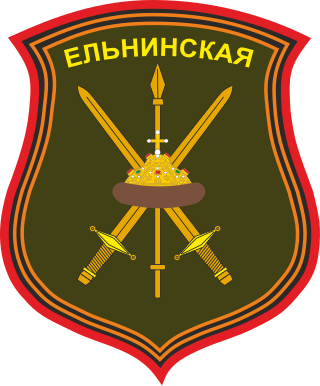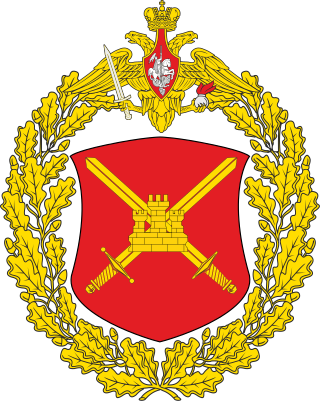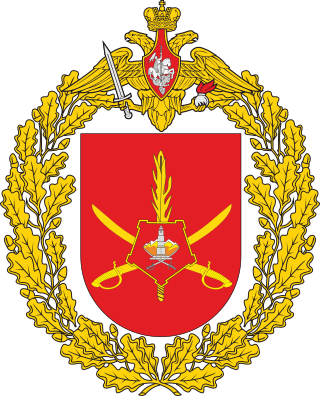Related Research Articles
The 1st Red Banner Army was a Red Army field army of World War II that served in the Soviet Far East.
Barrier troops, blocking units, or anti-retreat forces are military units that are located in the rear or on the front line to maintain military discipline, prevent the flight of servicemen from the battlefield, capture spies, saboteurs and deserters, and return troops who flee from the battlefield or lag behind their units.

The 144th Guards Yelnya Red Banner Order of Suvorov Motor Rifle Division is a motorized infantry division of the Russian Ground Forces, reestablished in 2016 with its headquarters at Yelnya, Smolensk Oblast.

The 150th Idritsa-Berlin Order of Kutuzov 2nd Class Motor Rifle Division of the Russian Ground Forces is a tank and artillery division that was re-instituted in 2016. It is part of the 8th Guards Army, which was reformed in 2017, in the Southern Military District.

The 97th Guards Mechanized Brigade was a rifle, and then a motor-rifle division of the Soviet Union's Army, before becoming a mechanized brigade of the Ukrainian Ground Forces, based in Slavuta in western Ukraine.
The 2nd Rifle Corps was an infantry corps of the Red Army during the interwar period and World War II, formed twice.
The 1st Guards Zvenigorod–Bucharest Red Banner Order of Suvorov Airborne Division was a division of the Soviet Airborne Troops. The division was first formed in December 1942 and fought in the Battle of the Dnieper, the Battle of the Korsun–Cherkassy Pocket, the Uman–Botoșani offensive, the second Jassy–Kishinev offensive, the Battle of Debrecen, the siege of Budapest and the Prague offensive. In August 1945 it was sent east and fought in the Soviet invasion of Manchuria. The division became the 124th Guards Rifle Division in November 1945 and disbanded in 1956.
It was a division of the Red army active from 1940 to at least 1945.
The 22nd Motor Rifle Division named for Atamyrat Niyazov is a division of the Turkmenistan Ground Forces. It traces its history to the 344th Rifle Division, an infantry division of the Red Army and the Soviet Ground Forces during World War II and the Cold War.

The 35th Guards Rifle Division was a division of the Soviet Red Army in World War II.
The 114th Rifle Division began service in July 1939 as a standard Red Army rifle division, as part of the pre-war expansion of the Soviet forces. It was stationed on the Svir River front in the autumn of 1941 and had a relatively uneventful war facing the Finns until the Vyborg–Petrozavodsk Offensive began on June 10, 1944, from which point it saw much more active service. As the Finns were leaving the war the division was transferred to 14th Army in the Arctic, from where it helped to defeat and pursue the German forces from Lapland into Norway.
Mikhail Afanasyevich Demichev was a Red Army komdiv. He fought in the Imperial Russian Army in World War I before going over to the Bolsheviks in the subsequent Civil War. He was a recipient of the Order of the Red Banner. During the Great Purge, he was arrested on August 9, 1937, and later executed. After the death of Joseph Stalin, he was rehabilitated in 1956.

Yelisey Ivanovich Goryachev was a Soviet Komkor. He fought in the Imperial Russian Army in World War I before going over to the Bolsheviks.
The 59th Rifle Division was an infantry division of the Red Army and briefly of the Soviet Army.
The 365th Rifle Division began forming on 1 September 1941, as a standard Red Army rifle division, in the Sverdlovsk Oblast. After forming, it was assigned to the 30th Army of Western Front, served briefly in the defense of Moscow, and played a role in the liberation of Klin, and later in the near-encirclement of the German 9th Army around Rzhev in the winter counteroffensive of 1941–42. In late January 1942, it was transferred to the 29th Army of Kalinin Front, which was very soon after encircled by German forces near Sychevka, and on 18 March the division was disbanded due to very heavy losses. In November 1944, a new 365th Rifle Division was formed in the Far Eastern Front, based on the 29th Rifle Brigade, and saw action in the Soviet invasion of Manchuria in August 1945, being awarded the Order of the Red Banner for its services.

The 172nd Rifle Division was an infantry division of the Red Army during World War II, formed thrice.

The 15th Separate Guards Motorized Rifle Alexandria (Peacekeeping) Brigade, Military Unit Number 90600, is a unit in the Russian Ground Forces. It is the only named peacekeeping brigade in the Russian Armed Forces. The formation is part of the 2nd Guards Combined Arms Army of the Central Military District. It is based in Roshchinsky in Volzhsky District of Samara Oblast.
The 51st Air Defense Division, abbreviated 51 dpvo, is an air defense formation of the 4th Air and Air Defence Forces Army of the Russian Aerospace Forces, which in turn is operationally subordinate to the Southern Military District. The headquarters is located in Novocherkassk.
The 103rd Rocket Red Banner, Orders of Kutuzov and Bohdan Khmelnytskyi Brigade, is a tactical surface-to-surface missile formation of the Ground Forces of the Russian Federation. Its Military Unit Number is 47130. It is equipped with the 9K720 Iskander tactical ballistic missile.
Stepan Ivanovich Polyansky was a Soviet officer, participant in the Soviet-Finnish war. Regiment and division commander in the Great Patriotic War. Hero of the Soviet Union (04/07/1940). Lieutenant colonel (1943).
References
- 1 2 3 4 5 6 7 8 9 Мороз Андрей Витальевич (2011). "Штрафной полк" (in Russian). CyberLeninka . Retrieved 17 March 2020.
- 1 2 "Сохранить честь. Как русские воины спасали свои знамена от врага" (in Russian). RIA Novosti. 9 February 2019. Retrieved 17 March 2020.
- 1 2 3 Руслан Иринархов. Агония 1941. Кровавые дороги отступления (in Russian). Retrieved 17 March 2020.
- ↑ ""Объявить НКВД преступной организацией"". Za Russkoye Delo (in Russian). 27 November 2010. Retrieved 17 March 2020.
- 1 2 3 4 5 Децюк Андрей Русланович (2017). "Советские воинские знамена 1941-1945 годов: социокультурный аспект" (PDF) (in Russian). Moscow Region State University. Retrieved 17 March 2020.
- ↑ "Немецкие солдаты с захваченными советскими полковыми знаменами" (in Russian). Waralbum. Retrieved 17 March 2020.
- ↑ "Stock Photo". Agefotostock. Retrieved 17 March 2020.
- ↑ Zovfefe (2017-07-18). "Finnish soldiers pose with a captured Soviet flag, date unknown. [4961x3663]". r/MilitaryPorn. Retrieved 2023-07-30.
- 1 2 Олег Нуждин. Уманский "котел". Трагедия 6-й и 12-й армий (in Russian). Retrieved 17 March 2020.
- 1 2 "Знамена конкретных частей Советской армии и частей МВД" (in Russian). Russian Centre of Vexillology and Heraldry. Retrieved 17 March 2020.
- ↑ "Немецкие солдаты позируют с захваченным знаменем советского 243-го стрелкового полка" (in Russian). Waralbum. Retrieved 17 March 2020.
- ↑ Верхотуров Дмитрий Николаевич. Клевета на Победу [Как оболгали Красную Армию-освободительницу] (in Russian). Retrieved 17 March 2020.
- ↑ Бакланов Григорий. Жизнь, подаренная дважды (in Russian). Retrieved 19 March 2020.
- ↑ "Cross of Sorrow". heninen.net. Retrieved 2024-03-21.
- ↑ Егоров Дмитрий. 1941. Разгром Западного фронта (in Russian). Retrieved 18 March 2020.
- ↑ "181-я стрелковая дивизия— соединение РККА в Великой Отечественной войне" (in Russian). RKKAWWII.ru. Retrieved 17 March 2020.
- ↑ Александр Лепехин. На Дедиловском направлении. Великая Отечественная война на территории Киреевского района (in Russian). Retrieved 17 March 2020.
- ↑ Ромайкин Иван Александрович (2012). "Боевой путь 355-ой Кировской стрелковой дивизии Калининского фронта (26.12.1941 – сер. июля 1942 гг.)". Исторические исследования: материалы Междунар. науч. конф. (in Russian). Retrieved 17 March 2020.
- ↑ Д. С. Никифоров. "История боевого пути 365 гвардейской стрелковой дивизии первого формирования" (PDF) (in Russian). Ural State Pedagogical University. Retrieved 18 March 2020.